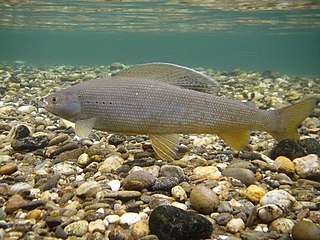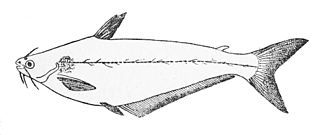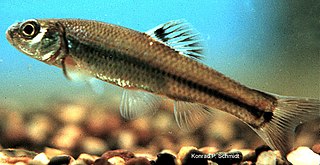
The flathead catfish, also called by several common names including mudcat or shovelhead cat, is a large species of North American freshwater catfish in the family Ictaluridae. It is the only species of the genus Pylodictis. Ranging from the lower Great Lakes region to northern Mexico, it has been widely introduced and is an invasive species in some areas. The closest living relative of the flathead catfish is the much smaller widemouth blindcat, Satan eurystomus.

The Ictaluridae, sometimes called ictalurids, are a family of catfish native to North America, where they are an important food source and sometimes fished for sport. The family includes about 51 species, some commonly known as bullheads, madtoms, channel catfish, and blue catfish.

The brown bullhead is a fish of the family Ictaluridae that is widely distributed in North America. It is a species of bullhead catfish and is similar to the black bullhead and yellow bullhead. It was originally described as Pimelodus nebulosus by Charles Alexandre Lesueur in 1819, and is also referred to as Ictalurus nebulosus.

The Arctic grayling is a species of freshwater fish in the salmon family Salmonidae. T. arcticus is widespread throughout the Arctic and Pacific drainages in Canada, Alaska, and Siberia, as well as the upper Missouri River drainage in Montana. In the U.S. state of Arizona, an introduced population is found in the Lee Valley and other lakes in the White Mountains. They were also stocked at Toppings Lake by the Teton Range and in lakes in the high Uinta Mountains in Utah, as well as alpine lakes of the Boulder Mountains (Idaho) in central Idaho.

The walking catfish is a species of freshwater airbreathing catfish native to Southeast Asia. It is named for its ability to "walk" and wiggle across dry land, to find food or suitable environments. While it does not truly walk as most bipeds or quadrupeds do, it has the ability to use its pectoral fins to keep it upright as it makes a wiggling motion with snakelike movements to traverse land. This fish normally lives in slow-moving and often stagnant waters in ponds, swamps, streams, and rivers, as well as in flooded rice paddies, or temporary pools that may dry up. When this happens, its "walking" skill allows the fish to move to other aquatic environments. Considerable taxonomic confusion surrounds this species and it has frequently been confused with other close relatives. One main distinction between the walking catfish and the native North American ictalurid catfish with which it sometimes is confused, is that the walking catfish lacks an adipose fin.

The black bullhead or black bullhead catfish is a species of bullhead catfish. Like other bullhead catfish, it has the ability to thrive in waters that are low in oxygen, brackish, turbid and/or very warm. It also has barbels located near its mouth, a broad head, spiny fins, and no scales. It can be identified from other bullheads as the barbels are black, and it has a tan crescent around the tail. Its caudal fin is truncated. Like virtually all catfish, it is nocturnal, preferring to feed at night, although young feed during the day. It generally does not get as large as the channel or blue catfish, with average adult weights are in the 1-to-2-pound range, and almost never as large as 4 pounds (1.8 kg). It has a typical length of 8–14 inches (20–36 cm), with the largest specimen being 24 inches (61 cm), making it the largest of the bullheads. It is typically black or dark brown on the dorsal side of its body and yellow or white on the ventral side.

The yellow bullhead is a species of bullhead catfish, a ray-finned fish that lacks scales.

Ameiurus is a genus of catfishes in the family Ictaluridae. It contains the three common types of bullhead catfish found in waters of the United States, the black bullhead, the brown bullhead, and the yellow bullhead, as well as other species, such as the white catfish, which are not typically called "bullheads".

The African butter catfish is a species of fish in the family Schilbeidae. It is native to many major river systems in Africa. Other common names for the fish include butter fish, butter barbel, African glass catfish, lubangu, mystus catfish, silver barbel, and silver catfish. It was originally described as Silurus mystus by Carl Linnaeus in 1758.
Noturus flavus, the stonecat, is a North American freshwater catfish of the family Ictaluridae. The common name is due to its habit of hiding near or under stones in fast-moving water.

Pterygoplichthys multiradiatus is one of several tropical fish commonly known as Orinoco sailfin catfish, plecostomus. It belongs to the armored catfish family (Loricariidae). Named for its sail-like dorsal fin, the part of its scientific name multiradiatus means "many-rayed" and refers to the rays of the dorsal fin. P. multiradiatus is one of a number of species commonly referred to as the common pleco by aquarists.

The bullhead minnow is a species of freshwater demersal fish, native to the southern United States.

Ameiurus platycephalus, the flat bullhead, is a species of North American freshwater catfish native to the waters of the southeastern United States from Virginia to Georgia. This species grows to a maximum length of 29 cm (11 in) TL though it is more commonly about 23 cm (9 in) long.

The brindled madtom is a small catfish of the family Ictaluridae that is native to the eastern United States.

The snail bullhead is a bony fish in the family Ictaluridae distributed widely in the southeastern United States. Among its bullhead catfish congeners, it has many North American relatives, like the brown bullhead and black bullhead. The species was described in 1877 by David Starr Jordan in the Ocmulgee River in Georgia.















